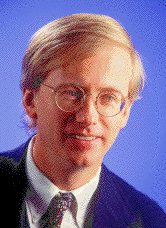 audio clip available
audio clip available
R. P. C. Rodgers first contacted Medical Informatics in high school, when he was fortunate to be accepted for an experimental program which placed him in a summer job working for the group of Dr. Homer Warner at the University of Utah, pioneers in computer-aided medical monitoring and diagnosis. He was awarded a BA in Biochemical Sciences from Harvard College, and a M.D. from the University of Utah, and subsequently did postdoctoral training at the University of London, U.K., the Laboratory for Theoretical Biology at the National Cancer Institute, and the International Institute for Cellular and Molecular Pathology in Brussels, Belgium. He completed a residency in Clinical Pathology at the University of California, San Francisco, where he subsequently joined the faculty of the Department of Laboratory Medicine, receiving a subsequent appointment in the Department of Pharmaceutical Chemistry.
Rodgers joined the Lister Hill National Center for Biomedical Communications (a research and development arm of the U.S. National Library of Medicine) in 1992, where he works on the Information Sources Map (ISM) Project, one of the three components of the Unified Medical Language System (UMLS) Project. The ISM is attempting to develop biomedical information retrieval tools which fully exploit diverse information sources available over high-speed wide-area computer networks, while remaining useful to clinicians and scientists using small personal computers and telephonic communications.
The first stab at this problem is Sourcerer, a prototype system which attempts to: accept a user query, employ the ISM database of information sources to determine which network resources are potentially useful; attach to the identified resources and retrieve appropriate information; and, return its findings to the requestor. Sourcerer is currently under development in collaboration with colleagues at the Clearinghouse for Networked Information Discovery and Retrieval (CNIDR).
Sourcerer is built on top of World-Wide Web (WWW) technology. Rodgers has been very active in this arena, having created HyperDOC, the NLM's WWW server, and (with collaborators) various new services associated with HyperDOC. These include multimedia exhibits from the History of Medicine Division, and OnLine Images (OLI, a system for the delivery of cataloged image collections). Rodgers is a member of the International World-Wide Web Conference Committee (IW3C2), and currently chairs the NSF/NCSA World-Wide Web Federal Consortium. He has participated in the planning committees and/or editorial committees for the first three International World-Wide Web Conferences, and supervised multicasting of the conferences from Chicago and Darmstadt.
Dr. Rodgers has published a book, several book chapters, and a number of journal articles on various aspects of computer-aided design, optimization, and analysis of clinical chemical analytical methods and the predictive power of clinical laboratory tests, the application of computers in diverse areas of medicine, and network-based biomedical information retrieval. Five of the software systems he developed while at the University of California are now licensed to outside users by the University.
Refer also to the full curriculum vitae (PostScript format).